The Linkage between Renewable Energy and Project Management: What Do We Already Know, and What Are the Future Directions of Research?
Abstract
:1. Introduction
2. Methodology
3. Results
3.1. Bibliometric Analyses of the PM–RE Research Field
3.2. The Results of Keyword Network Analyses
3.3. Findings from H-Core Articles
3.3.1. Contribution to a PM Domain
3.3.2. Contribution to the Technological Domain
3.3.3. Research Directions Identified in H-Core Studies
4. Discussion
5. Conclusions
5.1. Contributions
5.2. Limitations
Author Contributions
Funding
Data Availability Statement
Conflicts of Interest
Appendix A
| Article No. | Authors | Year of Publication | Number of Citations Received | Contribution—PM Domain | Contribution—Technological Domain | Future Research Directions—PM Domain | Future Research Directions—Technological Domain |
|---|---|---|---|---|---|---|---|
| 1 | [33] | 2009 | 449 | - The applied method has to design one hybrid project to supply power for a telecommunication relay station. | - optimum match design sizing method for hybrid solar–wind system based on the Genetic Algorithm (GA) | -specifications for wind power project, possible benchmark | - The model can be used to calculate the system optimum project configuration. |
| 2 | [34] | 2008 | 402 | - Stakeholder: renewable energy projects can become more locally divisive and controversial if benefits are not generally shared among local people. | - The paper focuses on community, and there is no contribution to the technological domain. | - More cases need to be examined. | - acceptance for new technologies (stakeholders): substantial involvement of local people |
| 3 | [36] | 2010 | 336 | - case studies regarding trust and community when it comes to the context of community renewable energy | - Technological aspects were not the point in this study. | - need to guard against simplistic prescriptions of “what works” and the notion that community projects can simply be replicated from place to place | - Technological aspects were not the point in this study. |
| 4 | [35] | 2005 | 282 | - Stakeholder aspects: the public is generally positive towards wind power projects. | - implications for green technology in context of its acceptance | - The potential of markets for ‘‘green’’ electricity may be limited. | - Future research in technological domain aspect was not the point in this study. |
| 5 | [43] | 2008 | 279 | - UK schemes should be lower-cost mechanisms when compared to the German ones. | - paper-focused, rather than focused on the technological aspect, focus on assessing the outcomes of the different policies with a focus on onshore wind | - obtaining the individual, community, or regional support for additional deployment of wind turbines | - paper-focused, rather than focused on technological aspect, focus on assessing the outcomes of the different policies with a focus on onshore wind |
| 6 | [60] | 2011 | 243 | - The research mainly focused on technological aspect and implementing technology in the end-to-end communication architecture for smart grids. | - successfully implemented communication within the REMPLI project, including the support for the IEC 1107, M-Bus, and the IEC 60870-5-101/104 | - The research mainly focused on technological aspect and implementing technology in the end-to-end communication architecture for smart grids. | - The top-level routing mechanism over IP (at the de/mux layer) even allows integrating different field-level networks at the same time. Thus, there might be dedicated APs for, e.g., nodes reachable over PLC and over GSM, respectively |
| 7 | [44] | 2004 | 203 | - several reasons for the success of countries using feed-in tariffs | - Insufficient technologies and higher costs are significant problems for photovoltaic energy sources and energy from tides or waves. | - identifying a number of success conditions for an increased use of RES | - grid capacity—a very important obstacle in promoting renewable energy technology |
| 8 | [45] | 2005 | 178 | - impossible to discern one single driver for wind power project development in the United States | - key factors at play in the 12 states in which a substantial amount of wind energy capacity has been developed or planned | - The RPS state policy appears to be the most effective. | - State policy must operate in the general context of the wind resource. |
| 9 | [61] | 1997 | 137 | - The paper focuses on technological aspects of implementing a sustainable sanitary system. | - sustainable sanitary system basing on vacuum toilets and vacuum sewage | - The paper focuses on technological aspects of implementing a sustainable sanitary system. | - Existing sewerage and treatment plants are technically written off |
| 10 | [62] | 2012 | 130 | - The paper focuses on technological aspects and investigates the planning and operation of combined wind storage systems. | - proposing an approach for planning and operating an energy storage system for a wind farm | - The paper focuses on technological aspects and investigates the planning and operation of combined wind storage systems. | - Further improvements of the method can consider an overall maximization of NPV. |
| 11 | [63] | 2009 | 116 | - Project management aspects were not the point in this study. | - estimating aboveground carbon (AGC) and assess and model its spatial variability by combining multispectral high resolution remote sensing imagery | - Project management aspects were not the point in this study. | - comparison of linear regression and k-NN prediction showed advantages for the regression approach |
| 12 | [37] | 2008 | 114 | - The energy awareness and ‘‘provoked’’ energy-efficient behavior must be established through repetition during school years. | - Technological aspects were not the case in the context of this paper. | - the introduction of a sustainable energy-related module at schools | - Technological aspects were not the case in the context of this paper. |
| 13 | [65] | 2013 | 107 | - uncertainty in the NW European shelf wave resource | - applying the third-generation wave model SWAN (Simulating Waves Nearshore) at high resolution | - It may be possible to estimate how the European wave resource will similarly vary over periods. | - The model improves the representation of the physical processes, particularly the non-linear wave–wave interactions. |
| 14 | [54] | 2011 | 99 | - importance of properly defining, beyond the design value, also the yields of each material recovered. | - production of residues and material recovery, optimization the overall efficiency of the IWMS | - planning a new MSW management system, material recovery process | - optimization of material and energy recovery activities |
| 15 | Shakya [70] | 2005 | 97 | - parameters used for financial analysis of the project | - the technical feasibility and perform the financial analysis of hybrid wind system | - Costs referred to the current state of technology. | - estimation resources for Australian regions and comparison with results in Cooma |
| 16 | [69] | 2010 | 95 | - sustainability assessment methodology and prediction the outcomes of the interventions by learning model | - model on rural mini-hybrid off-grid electrification system to determine the sustainability performance | - understanding the complexity of social-institutional (and ecological) systems | - resilience parameters and associated factors for the design of technological systems |
| 17 | [40] | 2007 | 94 | - information about facilitating clean energy development in developing countries | - means of daily solar irradiation maps | - usage of a map-based software application for decision making and policy analysis, identifying potential areas for wind and solar energy projects | -studying the effects of aerosols emitted, - refining techniques for determining cloud cover in regions |
| 18 | [64] | 2006 | 92 | - Grid-connected rooftop PV systems and solar photovoltaic energy offer a solution for supplying electricity to remote located communities and facilities. | - developments in the area of solar photovoltaic energy systems - energy as a sustainable energy supply | -undertaken extensive research projects for harnessing renewable energy sources | - Harness the sun’s energy to provide large-scale, domestically secure, and environmentally friendly electricity. |
| 19 | [49] | 2002 | 91 | - framework for the appraisal of power projects under uncertainty | - a case study of the wind energy-to-electricity production | - consideration if uncertainty increases the value of an option and options create value | - The future operating outcomes of a WE project can be influenced by future decisions, depending on the inherent operating options. |
| 20 | [67] | 2006 | 88 | - methodology to solve the MRCPSP by utilizing the features of PSO | - methodology for solving the Multimode Resource Constrained Project Scheduling Problem (MRCPSP) | - no research direction in project management domain | - consideration of stochastic activity duration and other application of PSO in the construction field |
| 21 | [68] | 2005 | 85 | - no contribution to project management domain. | - DSSC device structure, - electron transport in TiO2 DSSC, - electron injection of dye–TiO2 interface, UV irradiation effect on DSSC, alternative dyes | - conducting innovative research and technology development to make this potentially low-cost DSSC device commercially successful | -pushing the energy conversion efficiency to 15%, -developing all solid-state devices in preference to the liquid electrolyte that is currently used - pursuing radically new ideas such as use of QDs for spectral sensitization - solving issues related to large-scale module fabrication -addressing long-term stability issues |
| 22 | [66] | 2006 | 82 | -review of renewable energy projects realized by government | -discussion about effects of various renewable sources, solar, and biomass | - no research direction in project management domain. | - acceleration the growth of RETs utilization |
| 23 | [51] | 2001 | 73 | - schedule the activities to maximize the net present value | - depth-first branch-and-bound algorithm for the max-npv problem | - The branch-and-bound procedure is able to optimally solve instances with up to 30 activities and four resource types in a reasonable time limit. | - no research direction in technological domain |
| 24 | [41] | 2005 | 67 | - breakeven government subsidies | - evaluation total private and social benefits of landfill-gas-to-energy projects | - The method presented in the paper could be applied to other renewable energy technologies. | - Privately and socially cost-effective projects could and should be developed. |
| 25 | [52] | 2005 | 66 | - quantitative assessment of the costs, savings, and environmental benefits of renewable energy | - need to consider the non-market benefits of renewable energy in the assessment of overall costs and benefits, - plan for the expansion of the supply of wind and solar resources and the role of fossil fuels | -designs, new materials and better forecasting possibilities for renewable energy producers | - review of electricity infrastructure investments highlights |
| 26 | [58] | 2013 | 65 | - difficulty in gaining funding for poor performing turbine projects | - usage the TIS framework to evaluate the emergence of wind power innovation system | - evolutions in the technological issues - strengthening domestic science–industry complex | - A current list of TIS system functions could be used to analyze and visualize the formation and development of latecomer wind power TIS. |
| 27 | [50] | 2012 | 63 | - the evaluation of the economic, strategic, and environmental interest of biomass power projects | crop selection, development and processing of their lands to energy crops cultivation, additional support schemes are required to promote the necessary attractiveness of private investors for biomass power projects based on dedicated energy crops, | - Additional support schemes are required to promote the necessary attractiveness of private investors for biomass power projects based on dedicated energy crops. A guaranteed feed-in tariff is required to tackle the still perceive risk of these projects. | - the evaluation of the economic, strategic and environmental interest of biomass power projects |
| 28 | [55] | 2009 | 63 | - hybrid algorithm within of research to simulate and optimize thO29:R31e sustainability of urban developments. the algorithm to optimize the geometric form of a hypothetical urban development according to a simple fitness function—solar radiation availability. | Hybrid CMA-ES/HDE optimisation algorithm is proposed and compared with other selected methods (DE, HDE, ES, CSA-ES and CMA-ES) on two standards benchmarksfunctions: Ackley and Rastrigin. | - hybrid algorithm within of research to simulate and optimise thO29:R31e sustainability of urban developments - an algorithm to optimize the geometric form of a hypothetical urban development according to a simple fitness function—solar radiation availability. | |
| 29 | [42] | 2005 | 62 | - scenario, with a particular focus on the government policy for support of renewable generation. | This paper employs both primary and secondary evidence to analyze the benefits and implications of changes to renewable policies that could support small-scale and community-based renewables more effectively. | - If more support was given to smaller RE generation, then this could make a significant contribution to the RE generation mix. The primary and secondary data gathered here indicate that rural communities may be ready to embrace such policies. | - scenario, with a particular focus on the government policy for support of renewable generation. |
| 30 | [42] | 2003 | 61 | “The mixing of freshwater and seawater where a river flows into the salty ocean releases large amounts of energy. This phenomenon is known as osmosis. “ | |||
| 31 | [47] | 1999 | 59 | - planning, design and evaluation of a geothermal energy project | The application of decision-making methods developed in operational research for the optimum exploitation of geothermal resources is considered. The economic evaluation of projects is considered. | - In the case of multicriteria analysis, the main difficulty arises in the estimation of the required parameters that express personal preference. | - planning, design, and evaluation of a geothermal energy project. |
| 32 | [48] | 2011 | 58 | - energy balancing, calculation of minimal thermal energy demand, process optimization, heat integration, and, finally, the integration of renewable energy based on energetic considerations, a tool to reduce emissions and to give guidance for decisive actions in order to improve thermal energy efficiency. | - demonstrate the potential for reducing thermal energy consumption in breweries, to substantially lower fossil CO2 emissions and to develop an expert tool in order to provide a strategic approach to reach this reduction | - As technological change influences the thermal energy demand and hot water management of breweries significantly, process models for evaluating the best suitable technologies and operating conditions for an ideal heat integrated production site will be necessary. | - energy balancing, calculation of minimal thermal energy demand, process optimization, heat integration, and, finally, the integration of renewable energy based on energetic considerations - a tool to reduce emissions and to give guidance for decisive actions in order to improve thermal energy efficiency. |
| 33 | [53] | 2011 | 57 | - optimization of mass and energy flows | - identifying the optimal breakdown between material recovery and energy recovery from municipal solid waste (MSW) in the framework of integrated waste management systems (IWMS) | - optimization of mass and energy flows | |
| 34 | [38] | 2017 | 51 | - that requiring or incentivizing suppliers and companies to come with plans to reduce the emissions using alternative cement types, alternative aggregate substitutes that reduce water usage and use recycled industrial waste, encouraging the contracting company to seek suppliers close by to reduce the emissions resulting from the transportation to the gate does have significant impact on reduction of GHG emissions. | - a method to measure the impact of GHG emissions when concrete is used in construction. | - environmental supply chain and materials design research to solve this critical issue facing emerging economies | - This involves requiring or incentivizing suppliers and companies to come with plans to reduce the emissions using alternative cement types, alternative aggregate substitutes that reduce water usage and use recycled industrial waste, encouraging the contracting company to seek suppliers close by to reduce the emissions resulting from the transportation to the gate does have significant impact on reduction of GHG emissions. |
| 35 | [39] | 2013 | 47 | - energy policy of the political administration in the field of renewable energy | - overview of the country’s feed-in tariff | - The planning process for an updated FiT scheme (currently underway) should incorporate lessons from the regulation of successful FiT schemes in other countries and practice light-handed regulation wherever possible. | - energy policy of the political administration in the field of renewable energy |
| 36 | [59] | 2005 | 47 | - regulatory framework, guidelines on the design and implementation of energy efficiency measures | - policies and measures to promote energy efficiency, which involved analyzing the experience with instruments that are already implemented, and assessing innovative instruments that are proposed. In particular, the practicability of using ‘‘White Certificates’’ (energy efficiency) along the same lines as ‘‘Green Certificates’’ (renewable energy) was explored.” | “Guidelines on the design and implementation of energy efficiency measures, and in particular of the White Certificate systems, should be issued at the EU level, and the performance of the different systems at country and regional level monitored and benchmarked, so as to help in their further development and diffusion. The evaluation of projects should be standardized as much as possible and be based on simple and agreed criteria to calculate the baseline, as done in the UKand proposed for most technologies in Italy so as tosimplify procedures and reduce transaction costs.Due to the importance of transaction costs for the success of WhC schemes, R&D in this direction is recommended. Progressive implementation of the WhC scheme, gradually introducing new technologies and new sectors, may be considered.” | - regulatory framework, guidelines on the design and implementation of energy efficiency measures |
| 37 | [56] | 2014 | 46 | - identifies the facilitators and constraints that influenced the public contribution to the development of wind projects and provides guidelines for improving public consultation in decision-making regarding wind project development. | - technological, economic, social, or public barriers to renewable energy investment. | - still a need for further research on resolving social conflicts of wind project development. | - identifies the facilitators and constraints that influenced the public ontribution to the development of wind projects and provides guidelines for improving public consultation in decision-making regarding wind project development. |
| 38 | [57] | 2008 | 43 | - optimization | - The model was adapted from the GreenLab model and was used to estimate organ sink strengths by optimization against biomass measurements. | - optimization |
References
- Leach, M.; Rockström, J.; Raskin, P.; Scoones, I.; Stirling, A.C.; Smith, A.; Thompson, J.; Millstone, E.; Ely, A.; Arond, E.; et al. Transforming Innovation for Sustainability. Ecol. Soc. 2012, 17, art11. [Google Scholar] [CrossRef] [Green Version]
- Said, Z.; Sharma, P.; Thi Bich Nhuong, Q.; Bora, B.J.; Lichtfouse, E.; Khalid, H.M.; Luque, R.; Nguyen, X.P.; Hoang, A.T. Intelligent Approaches for Sustainable Management and Valorisation of Food Waste. Bioresour. Technol. 2023, 377, 128952. [Google Scholar] [CrossRef] [PubMed]
- Xue, J.; Yue, G.Y. Visualizing the Intellectual Structure of Risk Management in Renewable Energy Projects. IOP Conf. Ser. Earth Environ. Sci. 2020, 586, 012013. [Google Scholar] [CrossRef]
- Khalid, H.M.; Rafique, Z.; Muyeen, S.M.; Raqeeb, A.; Said, Z.; Saidur, R.; Sopian, K. Dust Accumulation and Aggregation on PV Panels: An Integrated Survey on Impacts, Mathematical Models, Cleaning Mechanisms, and Possible Sustainable Solution. Sol. Energy 2023, 251, 261–285. [Google Scholar] [CrossRef]
- Kern, F.; Rogge, K.S.; Howlett, M. Policy Mixes for Sustainability Transitions: New Approaches and Insights through Bridging Innovation and Policy Studies. Res. Policy 2019, 48, 103832. [Google Scholar] [CrossRef]
- Carrillo-Hermosilla, J.; Río, P.D.; Könnölä, T. Diversity of Eco-Innovations: Reflections from Selected Case Studies. J. Clean. Prod. 2010, 18, 1073–1083. [Google Scholar] [CrossRef]
- Rennings, K. Redefining Innovation—Eco-Innovation Research and the Contribution from Ecological Economics. Ecol. Econ. 2000, 32, 319–332. [Google Scholar] [CrossRef]
- Noppers, E.H.; Keizer, K.; Bolderdijk, J.W.; Steg, L. The Adoption of Sustainable Innovations: Driven by Symbolic and Environmental Motives. Glob. Environ. Chang. 2014, 25, 52–62. [Google Scholar] [CrossRef]
- Piwowar-Sulej, K. Organizational Culture and Project Management Methodology: Research in the Financial Industry. Int. J. Manag. Proj. Bus. 2021, 14, 1270–1289. [Google Scholar] [CrossRef]
- Rimita, K.; Hoon, S.N.; Levasseur, R. Leader Readiness in a Volatile, Uncertain, Complex, and Ambiguous Business Environment. J. Soc. Chang. 2020, 12. [Google Scholar] [CrossRef]
- Laszlo, C.; Cooperrider, D.; Fry, R. Global Challenges as Opportunity to Transform Business for Good. Sustainability 2020, 12, 8053. [Google Scholar] [CrossRef]
- Siegelaub, J.M. Six (Yes Six!) Constraints: An Enhanced Model for Project Control. In Proceedings of the PMI® Global Congress, Atlanta, GA, USA, 6–9 October 2007; Project Management Institute: Atlanta, GA, USA, 2007. [Google Scholar]
- Rolstadås, A.; Johansen, A. The Dawn of a New Era for Project Management. Sustainability 2021, 13, 695. [Google Scholar] [CrossRef]
- Rostova, O.; Shirokova, S.; Sokolitsyna, N.; Shmeleva, A. Management of Investment Process in Alternative Energy Projects. E3S Web Conf. 2019, 110, 02032. [Google Scholar] [CrossRef] [Green Version]
- Paul, J.; Criado, A.R. The Art of Writing Literature Review: What Do We Know and What Do We Need to Know? Int. Bus. Rev. 2020, 29, 101717. [Google Scholar] [CrossRef]
- Denyer, D.; Tranfield, D. Producing a Systematic Review. In The Sage Handbook of Organizational Research Methods; Buchanan, D.A., Bryman, A., Eds.; Sage Publications Ltd.: Thousand Oaks, CA, USA, 2009; pp. 671–689. [Google Scholar]
- Khezri, R.; Mahmoudi, A.; Aki, H. Optimal Planning of Solar Photovoltaic and Battery Storage Systems for Grid-Connected Residential Sector: Review, Challenges and New Perspectives. Renew. Sustain. Energy Rev. 2022, 153, 111763. [Google Scholar] [CrossRef]
- Busch, H.; Ruggiero, S.; Isakovic, A.; Hansen, T. Policy Challenges to Community Energy in the EU: A Systematic Review of the Scientific Literature. Renew. Sustain. Energy Rev. 2021, 151, 111535. [Google Scholar] [CrossRef]
- Felder, F.A.; Kumar, P. A Review of Existing Deep Decarbonization Models and Their Potential in Policymaking. Renew. Sustain. Energy Rev. 2021, 152, 111655. [Google Scholar] [CrossRef]
- Hekmatnia, H.; Fatahi Ardakani, A.; Mashayekhan, A.; Akbari, M. Assessing Economic, Social, and Environmental Impacts of Wind Energy in Iran with Focus on Development of Wind Power Plants. J. Renew. Energy Environ. 2020, 7, 67–79. [Google Scholar] [CrossRef]
- Gorbach, O.G.; Kost, C.; Pickett, C. Review of Internal Carbon Pricing and the Development of a Decision Process for the Identification of Promising Internal Pricing Methods for an Organisation. Renew. Sustain. Energy Rev. 2022, 154, 111745. [Google Scholar] [CrossRef]
- García Vera, Y.E.; Dufo-López, R.; Bernal-Agustín, J.L. Energy Management in Microgrids with Renewable Energy Sources: A Literature Review. Appl. Sci. 2019, 9, 3854. [Google Scholar] [CrossRef] [Green Version]
- Aguilar, J.; Garces-Jimenez, A.; R-Moreno, M.D.; García, R. A Systematic Literature Review on the Use of Artificial Intelligence in Energy Self-Management in Smart Buildings. Renew. Sustain. Energy Rev. 2021, 151, 111530. [Google Scholar] [CrossRef]
- Whittemore, R.; Knafl, K. The Integrative Review: Updated Methodology. J. Adv. Nurs. 2005, 52, 546–553. [Google Scholar] [CrossRef]
- Smith, G.M. Key Books in Business and Management Studies: A Bibliometric Analysis. Aslib Proc. 1977, 29, 174–188. [Google Scholar] [CrossRef]
- Xie, Y.; Ji, L.; Zhang, B.; Huang, G. Evolution of the Scientific Literature on Input–Output Analysis: A Bibliometric Analysis of 1990–2017. Sustainability 2018, 10, 3135. [Google Scholar] [CrossRef] [Green Version]
- Piwowar-Sulej, K.; Krzywonos, M.; Kwil, I. Environmental Entrepreneurship—Bibliometric and Content Analysis of the Subject Literature Based on H-Core. J. Clean. Prod. 2021, 295, 126277. [Google Scholar] [CrossRef]
- Martínez, M.A.; Herrera, M.; López-Gijón, J.; Herrera-Viedma, E. H-Classics: Characterizing the Concept of Citation Classics through H-Index. Scientometrics 2014, 98, 1971–1983. [Google Scholar] [CrossRef]
- Lewis, M.O.; Mathiassen, L.; Rai, A. Scalable Growth in IT-Enabled Service Provisioning: A Sensemaking Perspective. Eur. J. Inf. Syst. 2011, 20, 285–302. [Google Scholar] [CrossRef]
- Khan, A.; Hassan, M.K.; Paltrinieri, A.; Dreassi, A.; Bahoo, S. A Bibliometric Review of Takaful Literature. Int. Rev. Econ. Financ. 2020, 69, 389–405. [Google Scholar] [CrossRef]
- van Eck, N.J.; Waltman, L. Visualizing Bibliometric Networks. In Measuring Scholarly Impact; Springer International Publishing: Cham, Switzerland, 2014; pp. 285–320. [Google Scholar]
- Piwowar-Sulej, K. Core Functions of Sustainable Human Resource Management. A Hybrid Literature Review with the Use of H-Classics Methodology. Sustain. Dev. 2021, 29, 671–693. [Google Scholar] [CrossRef]
- Yang, H.; Wei, Z.; Chengzhi, L. Optimal Design and Techno-Economic Analysis of a Hybrid Solar–Wind Power Generation System. Appl. Energy 2009, 86, 163–169. [Google Scholar] [CrossRef]
- Walker, G.; Devine-Wright, P. Community Renewable Energy: What Should It Mean? Energy Policy 2008, 36, 497–500. [Google Scholar] [CrossRef]
- Ek, K. Public and Private Attitudes towards “Green” Electricity: The Case of Swedish Wind Power. Energy Policy 2005, 33, 1677–1689. [Google Scholar] [CrossRef]
- Walker, G.; Devine-Wright, P.; Hunter, S.; High, H.; Evans, B. Trust and Community: Exploring the Meanings, Contexts and Dynamics of Community Renewable Energy. Energy Policy 2010, 38, 2655–2663. [Google Scholar] [CrossRef]
- Zografakis, N.; Menegaki, A.N.; Tsagarakis, K.P. Effective Education for Energy Efficiency. Energy Policy 2008, 36, 3226–3232. [Google Scholar] [CrossRef]
- Arıoğlu Akan, M.Ö.; Dhavale, D.G.; Sarkis, J. Greenhouse Gas Emissions in the Construction Industry: An Analysis and Evaluation of a Concrete Supply Chain. J. Clean. Prod. 2017, 167, 1195–1207. [Google Scholar] [CrossRef]
- Tongsopit, S.; Greacen, C. An Assessment of Thailand’s Feed-in Tariff Program. Renew. Energy 2013, 60, 439–445. [Google Scholar] [CrossRef]
- Martins, F.R.; Pereira, E.B.; Abreu, S.L. Satellite-Derived Solar Resource Maps for Brazil under SWERA Project. Sol. Energy 2007, 81, 517–528. [Google Scholar] [CrossRef]
- Jaramillo, P.; Matthews, H.S. Landfill-Gas-to-Energy Projects: Analysis of Net Private and Social Benefits. Environ. Sci. Technol. 2005, 39, 7365–7373. [Google Scholar] [CrossRef] [Green Version]
- Hain, J.J.; Ault, G.W.; Galloway, S.; Cruden, A.; McDonald, J.R. Additional Renewable Energy Growth through Small-Scale Community Orientated Energy Policies. Energy Policy 2005, 33, 1199–1212. [Google Scholar] [CrossRef]
- Butler, L.; Neuhoff, K. Comparison of Feed-in Tariff, Quota and Auction Mechanisms to Support Wind Power Development. Renew. Energy 2008, 33, 1854–1867. [Google Scholar] [CrossRef] [Green Version]
- Reiche, D.; Bechberger, M. Policy Differences in the Promotion of Renewable Energies in the EU Member States. Energy Policy 2004, 32, 843–849. [Google Scholar] [CrossRef]
- Bird, L.; Bolinger, M.; Gagliano, T.; Wiser, R.; Brown, M.; Parsons, B. Policies and Market Factors Driving Wind Power Development in the United States. Energy Policy 2005, 33, 1397–1407. [Google Scholar] [CrossRef]
- Aaberg, R.J. Osmotic Power. Refocus 2003, 4, 48–50. [Google Scholar] [CrossRef]
- Goumas, M.; Lygerou, V.; Papayannakis, L. Computational Methods for Planning and Evaluating Geothermal Energy Projects. Energy Policy 1999, 27, 147–154. [Google Scholar] [CrossRef]
- Muster-Slawitsch, B.; Weiss, W.; Schnitzer, H.; Brunner, C. The Green Brewery Concept—Energy Efficiency and the Use of Renewable Energy Sources in Breweries. Appl. Therm. Eng. 2011, 31, 2123–2134. [Google Scholar] [CrossRef] [Green Version]
- Venetsanos, K.; Angelopoulou, P.; Tsoutsos, T. Renewable Energy Sources Project Appraisal under Uncertainty: The Case of Wind Energy Exploitation within a Changing Energy Market Environment. Energy Policy 2002, 30, 293–307. [Google Scholar] [CrossRef]
- Carneiro, P.; Ferreira, P. The Economic, Environmental and Strategic Value of Biomass. Renew. Energy 2012, 44, 17–22. [Google Scholar] [CrossRef] [Green Version]
- Vanhoucke, M.; Demeulemeester, E.; Herroelen, W. On Maximizing the Net Present Value of a Project Under Renewable Resource Constraints. Manag. Sci. 2001, 47, 1113–1121. [Google Scholar] [CrossRef]
- Alnatheer, O. The Potential Contribution of Renewable Energy to Electricity Supply in Saudi Arabia. Energy Policy 2005, 33, 2298–2312. [Google Scholar] [CrossRef]
- Consonni, S.; Giugliano, M.; Massarutto, A.; Ragazzi, M.; Saccani, C. Material and Energy Recovery in Integrated Waste Management Systems: Project Overview and Main Results. Waste Manag. 2011, 31, 2057–2065. [Google Scholar] [CrossRef]
- Giugliano, M.; Cernuschi, S.; Grosso, M.; Rigamonti, L. Material and Energy Recovery in Integrated Waste Management Systems. An Evaluation Based on Life Cycle Assessment. Waste Manag. 2011, 31, 2092–2101. [Google Scholar] [CrossRef]
- Kämpf, J.H.; Robinson, D. A Hybrid CMA-ES and HDE Optimisation Algorithm with Application to Solar Energy Potential. Appl. Soft Comput. 2009, 9, 738–745. [Google Scholar] [CrossRef]
- Jami, A.A.N.; Walsh, P.R. The Role of Public Participation in Identifying Stakeholder Synergies in Wind Power Project Development: The Case Study of Ontario, Canada. Renew. Energy 2014, 68, 194–202. [Google Scholar] [CrossRef]
- Christophe, A.; Letort, V.; Hummel, I.; Cournède, P.-H.; de Reffye, P.; Lecœur, J. A Model-Based Analysis of the Dynamics of Carbon Balance at the Whole-Plant Level in Arabidopsis Thaliana. Funct. Plant Biol. 2008, 35, 1147. [Google Scholar] [CrossRef]
- Gosens, J.; Lu, Y. From Lagging to Leading? Technological Innovation Systems in Emerging Economies and the Case of Chinese Wind Power. Energy Policy 2013, 60, 234–250. [Google Scholar] [CrossRef]
- Farinelli, U.; Johansson, T.B.; McCormick, K.; Mundaca, L.; Oikonomou, V.; Örtenvik, M.; Patel, M.; Santi, F. “White and Green”: Comparison of Market-Based Instruments to Promote Energy Efficiency. J. Clean. Prod. 2005, 13, 1015–1026. [Google Scholar] [CrossRef]
- Sauter, T.; Lobashov, M. End-to-End Communication Architecture for Smart Grids. IEEE Trans. Ind. Electron. 2011, 58, 1218–1228. [Google Scholar] [CrossRef]
- Otterpoh, R.; Grottker, M.; Lange, J. Sustainable Water and Waste Management in Urban Areas. Water Sci. Technol. 1997, 35, 121–133. [Google Scholar] [CrossRef]
- Dicorato, M.; Forte, G.; Pisani, M.; Trovato, M. Planning and Operating Combined Wind-Storage System in Electricity Market. IEEE Trans. Sustain. Energy 2012, 3, 209–217. [Google Scholar] [CrossRef]
- Fuchs, H.; Magdon, P.; Kleinn, C.; Flessa, H. Estimating Aboveground Carbon in a Catchment of the Siberian Forest Tundra: Combining Satellite Imagery and Field Inventory. Remote Sens. Environ. 2009, 113, 518–531. [Google Scholar] [CrossRef]
- Zahedi, A. Solar Photovoltaic (PV) Energy; Latest Developments in the Building Integrated and Hybrid PV Systems. Renew. Energy 2006, 31, 711–718. [Google Scholar] [CrossRef]
- Neill, S.P.; Hashemi, M.R. Wave Power Variability over the Northwest European Shelf Seas. Appl. Energy 2013, 106, 31–46. [Google Scholar] [CrossRef]
- Islam, A.K.M.S.; Islam, M.; Rahman, T. Effective Renewable Energy Activities in Bangladesh. Renew. Energy 2006, 31, 677–688. [Google Scholar] [CrossRef]
- Zhang, H.; Tam, C.M.; Li, H. Multimode Project Scheduling Based on Particle Swarm Optimization. Comput. Civ. Infrastruct. Eng. 2006, 21, 93–103. [Google Scholar] [CrossRef]
- Deb, S.K. Dye-Sensitized TiO2 Thin-Film Solar Cell Research at the National Renewable Energy Laboratory (NREL). Sol. Energy Mater. Sol. Cells 2005, 88, 1–10. [Google Scholar] [CrossRef]
- Brent, A.C.; Rogers, D.E. Renewable Rural Electrification: Sustainability Assessment of Mini-Hybrid off-Grid Technological Systems in the African Context. Renew. Energy 2010, 35, 257–265. [Google Scholar] [CrossRef] [Green Version]
- Shakya, B.D.; Aye, L.; Musgrave, P. Technical Feasibility and Financial Analysis of Hybrid Wind–Photovoltaic System with Hydrogen Storage for Cooma. Int. J. Hydrog. Energy 2005, 30, 9–20. [Google Scholar] [CrossRef]
- Gorzeń-Mitka, I.; Wieczorek-Kosmala, M. Mapping the Energy Sector from a Risk Management Research Perspective: A Bibliometric and Scientific Approach. Energies 2023, 16, 2024. [Google Scholar] [CrossRef]
- Li, M.; Lu, Y.; Xu, X. Mapping the Scientific Structure and Evolution of Renewable Energy for Sustainable Development. Environ. Sci. Pollut. Res. 2022, 29, 64832–64845. [Google Scholar] [CrossRef]
- Piterou, A.; Coles, A. A Review of Business Models for Decentralised Renewable Energy Projects. Bus. Strateg. Environ. 2021, 30, 1468–1480. [Google Scholar] [CrossRef]
- Niroumand, H.; Zain, M.F.; Jamil, M. A Guideline for Assessing of Critical Parameters on Earth Architecture and Earth Buildings as a Sustainable Architecture in Various Countries. Renew. Sustain. Energy Rev. 2013, 28, 130–165. [Google Scholar] [CrossRef]
- Köberle, A.C.; Garaffa, R.; Cunha, B.S.L.; Rochedo, P.; Lucena, A.F.P.; Szklo, A.; Schaeffer, R. Are Conventional Energy Megaprojects Competitive? Suboptimal Decisions Related to Cost Overruns in Brazil. Energy Policy 2018, 122, 689–700. [Google Scholar] [CrossRef]
- Agajie, T.F.; Ali, A.; Fopah-Lele, A.; Amoussou, I.; Khan, B.; Velasco, C.L.R.; Tanyi, E. A Comprehensive Review on Techno-Economic Analysis and Optimal Sizing of Hybrid Renewable Energy Sources with Energy Storage Systems. Energies 2023, 16, 642. [Google Scholar] [CrossRef]
- Weerasinghe, R.P.N.P.; Yang, R.J.; Too, E.; Le, T. Renewable Energy Adoption in the Built Environment: A Sociotechnical Network Approach. Intell. Build. Int. 2021, 13, 33–50. [Google Scholar] [CrossRef]
- Raven, R.P.J.M.; Jolivet, E.; Mourik, R.M.; Feenstra, Y.C.F.J. ESTEEM: Managing Societal Acceptance in New Energy Projects. Technol. Forecast. Soc. Change 2009, 76, 963–977. [Google Scholar] [CrossRef]
- Schmidt, T.S. Low-Carbon Investment Risks and de-Risking. Nat. Clim. Chang. 2014, 4, 237–239. [Google Scholar] [CrossRef]
- Steffen, B. The Importance of Project Finance for Renewable Energy Projects. Energy Econ. 2018, 69, 280–294. [Google Scholar] [CrossRef] [Green Version]
- Hussain, S.; Xuetong, W.; Maqbool, R.; Hussain, M.; Shahnawaz, M. The Influence of Government Support, Organizational Innovativeness and Community Participation in Renewable Energy Project Success: A Case of Pakistan. Energy 2022, 239, 122172. [Google Scholar] [CrossRef]
- Rasool, S.F.; Chin, T.; Wang, M.; Asghar, A.; Khan, A.; Zhou, L. Exploring the Role of Organizational Support, and Critical Success Factors on Renewable Energy Projects of Pakistan. Energy 2022, 243, 122765. [Google Scholar] [CrossRef]
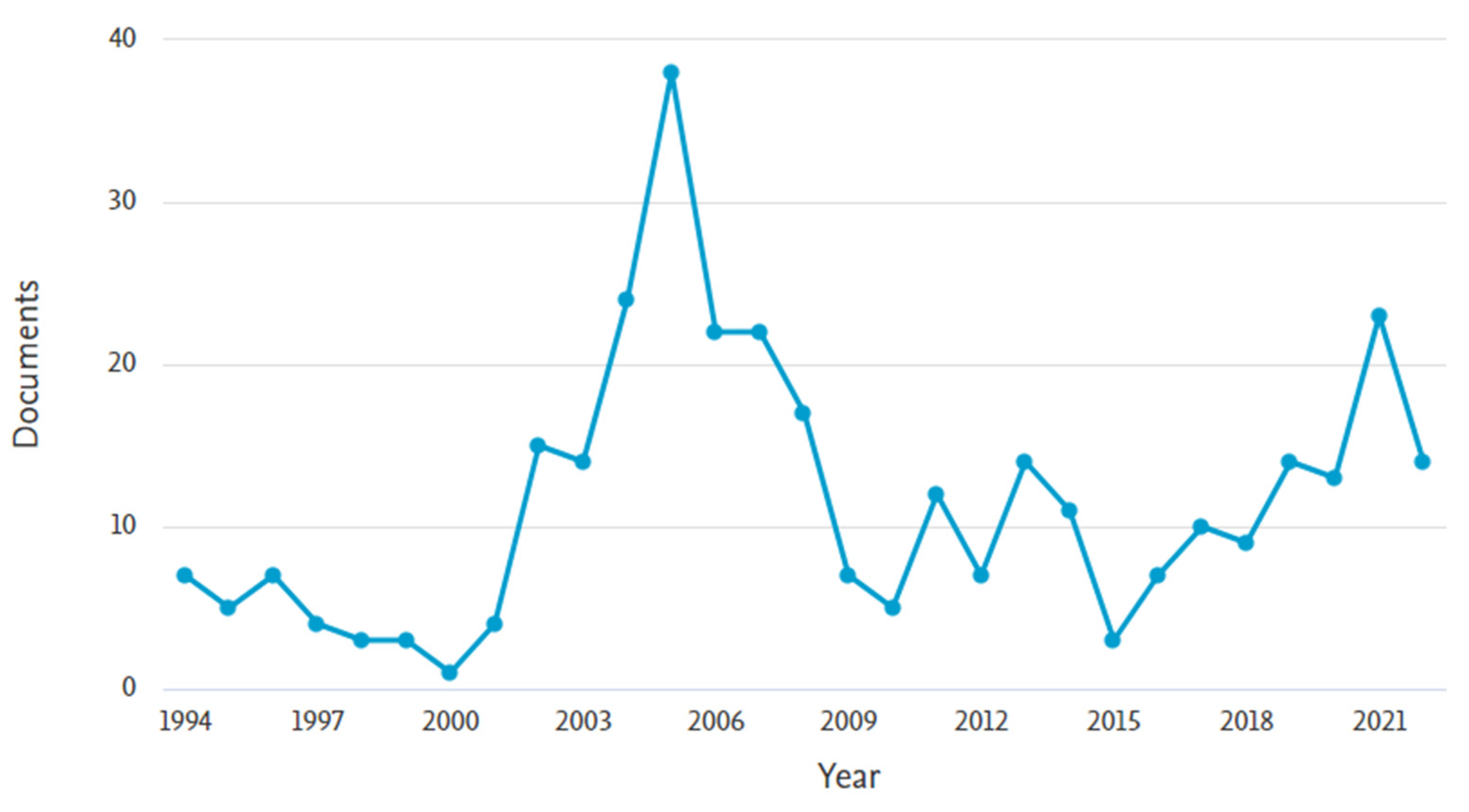
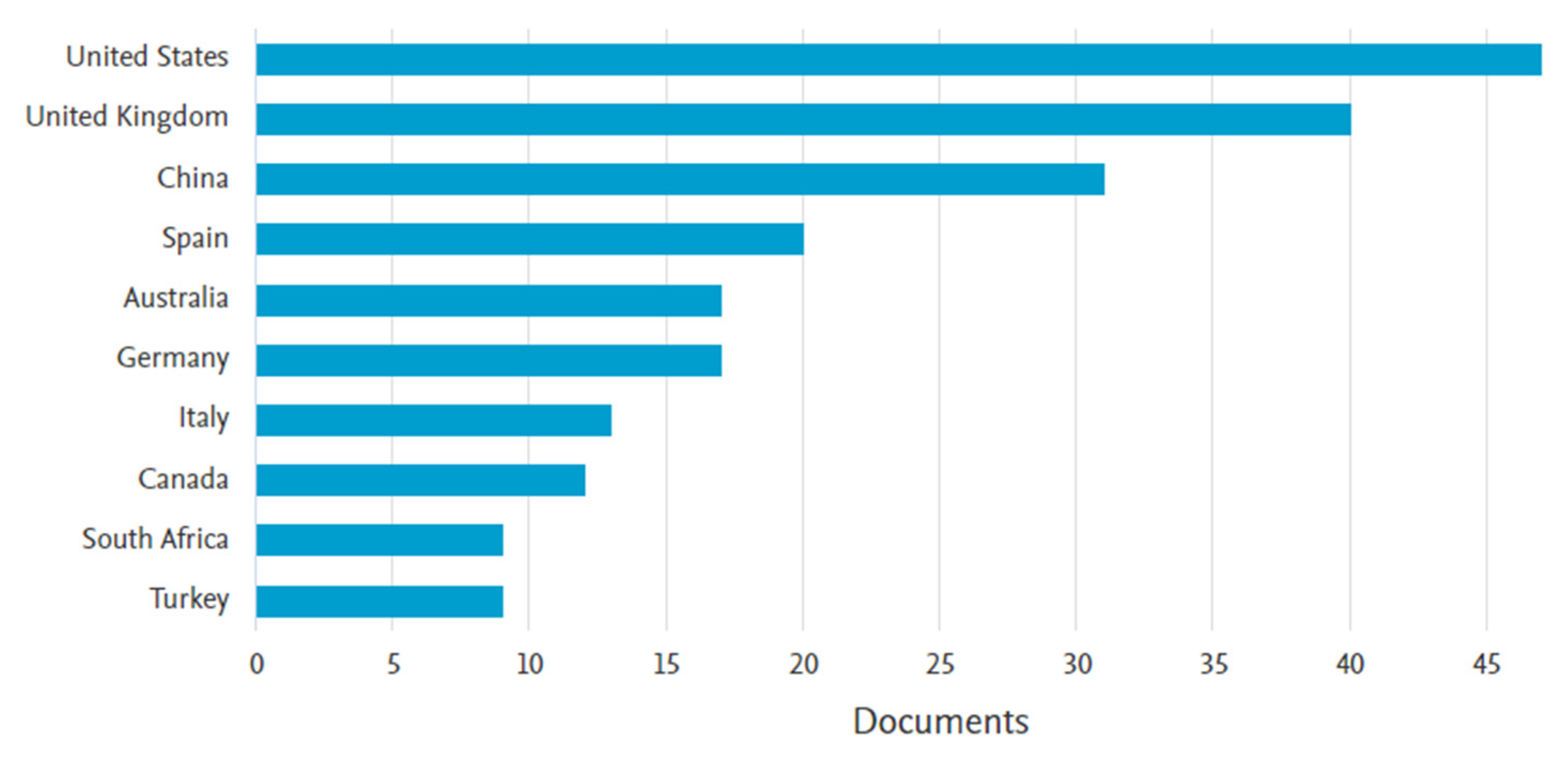
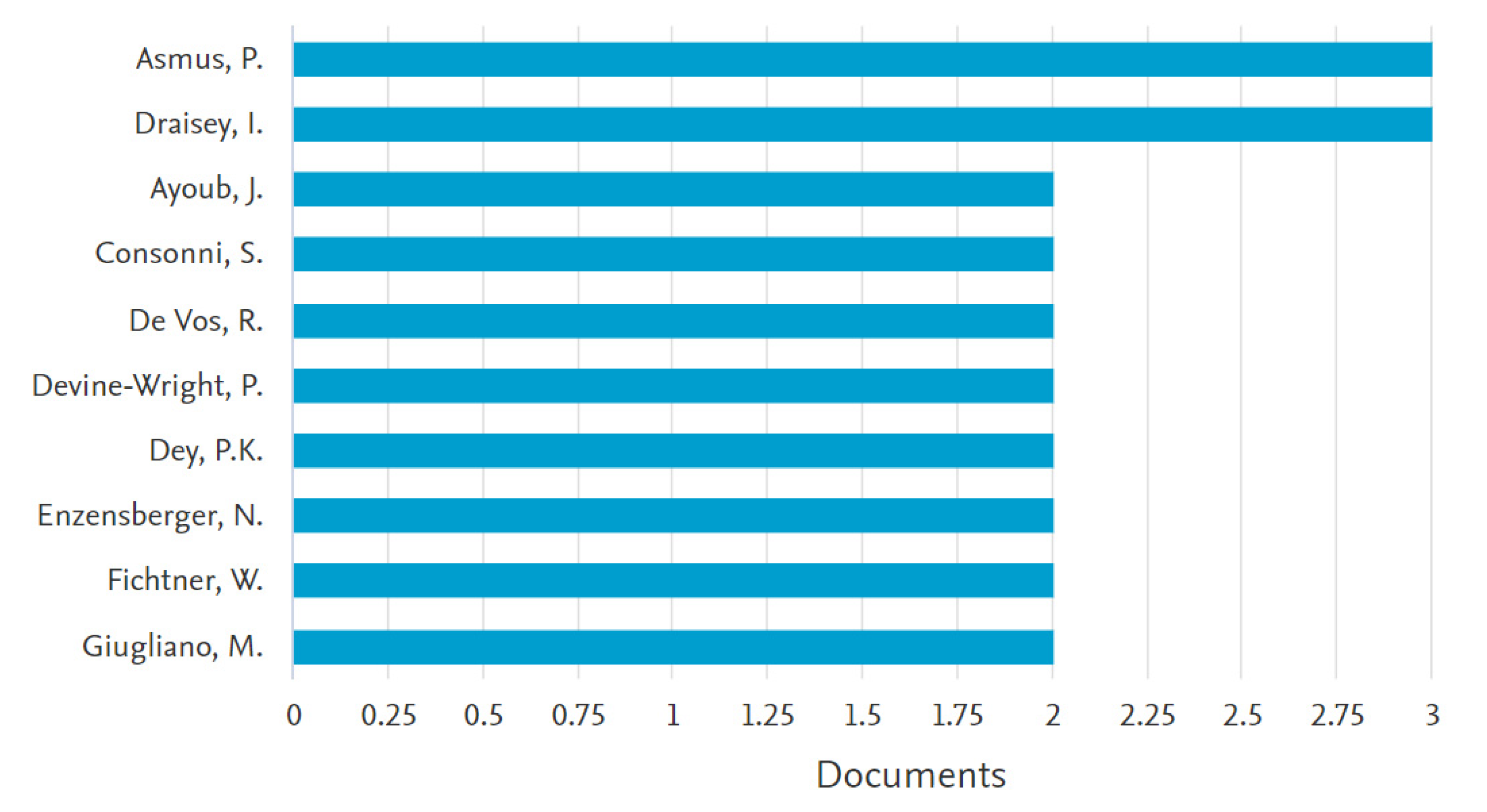
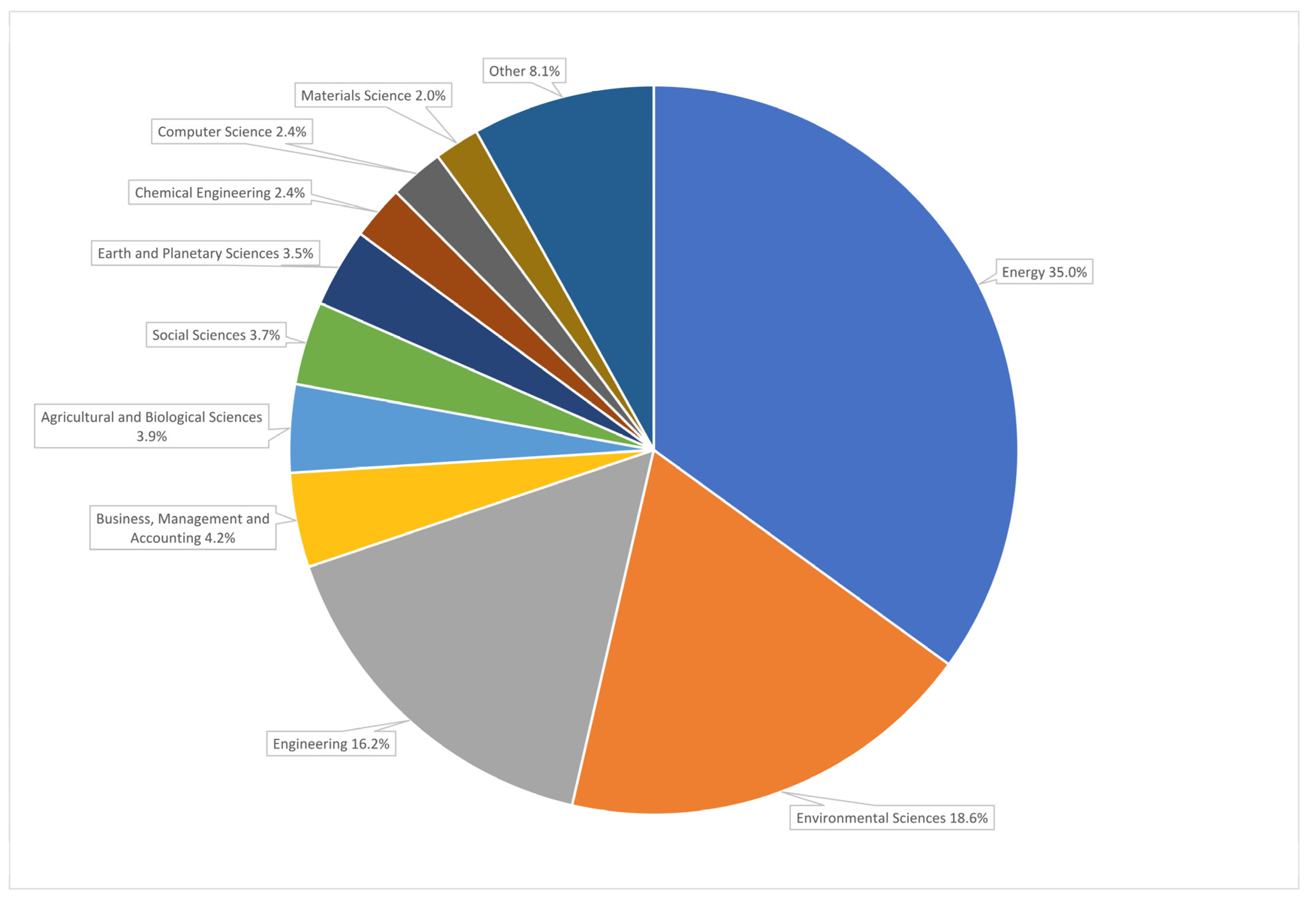
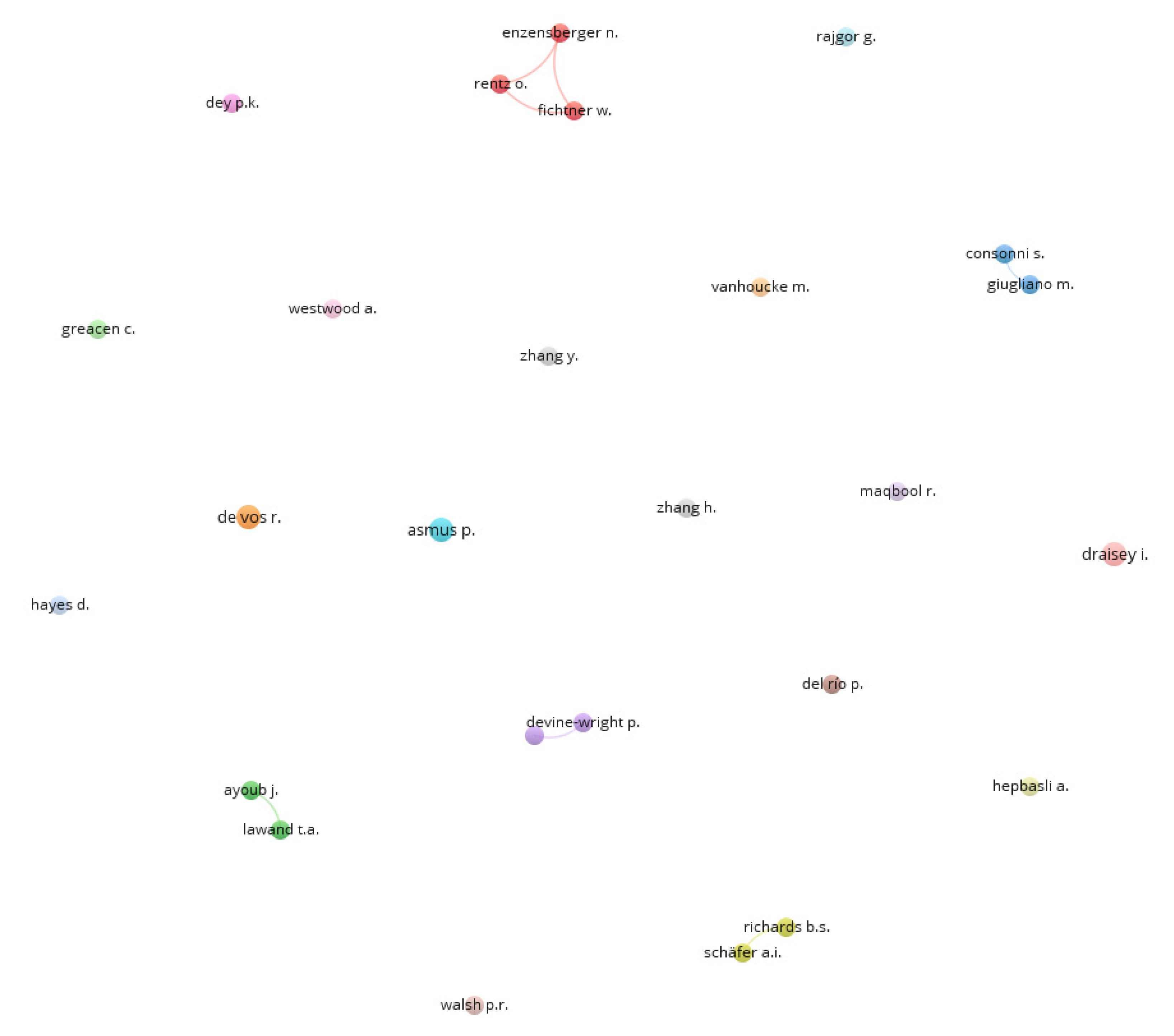
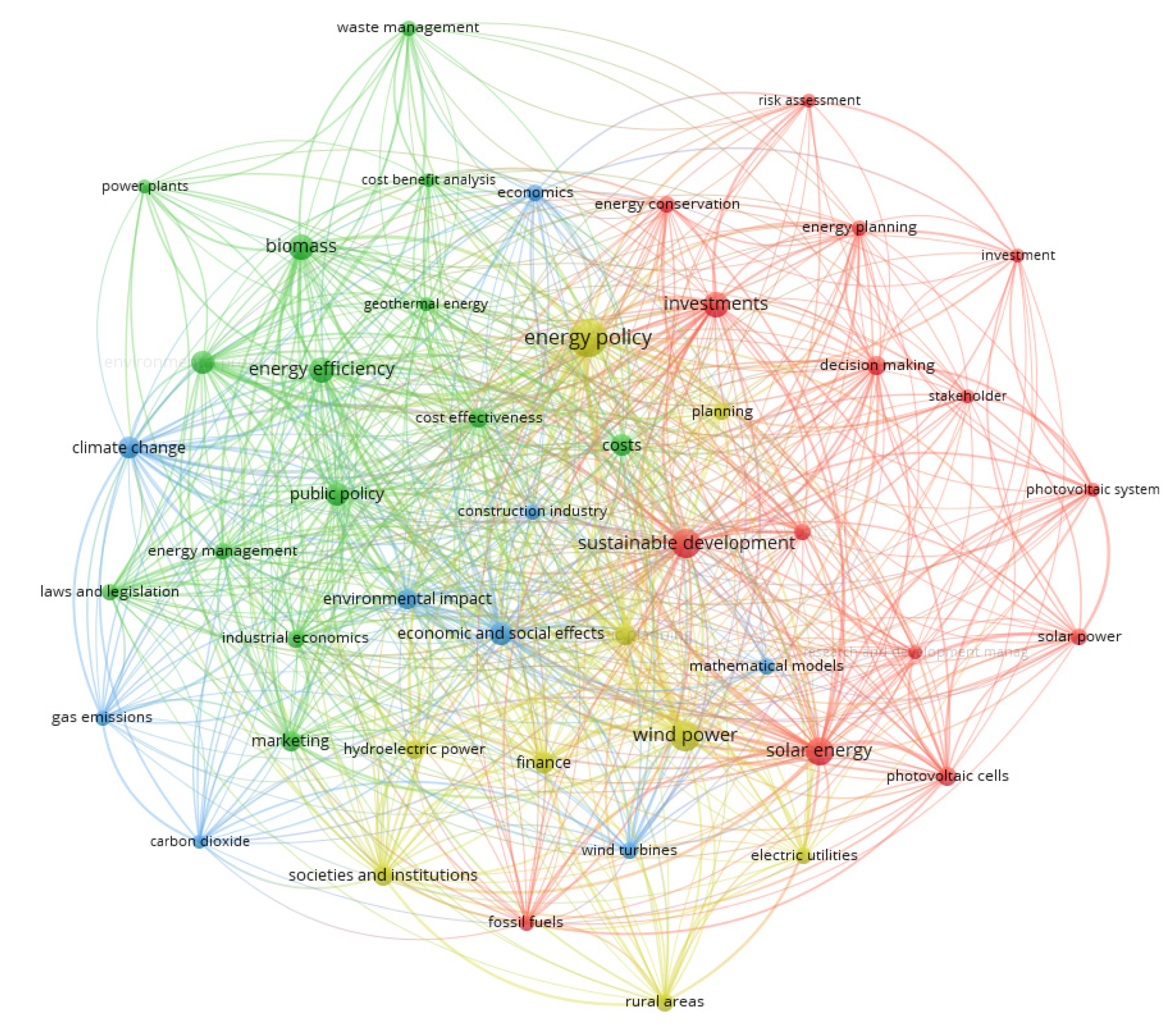
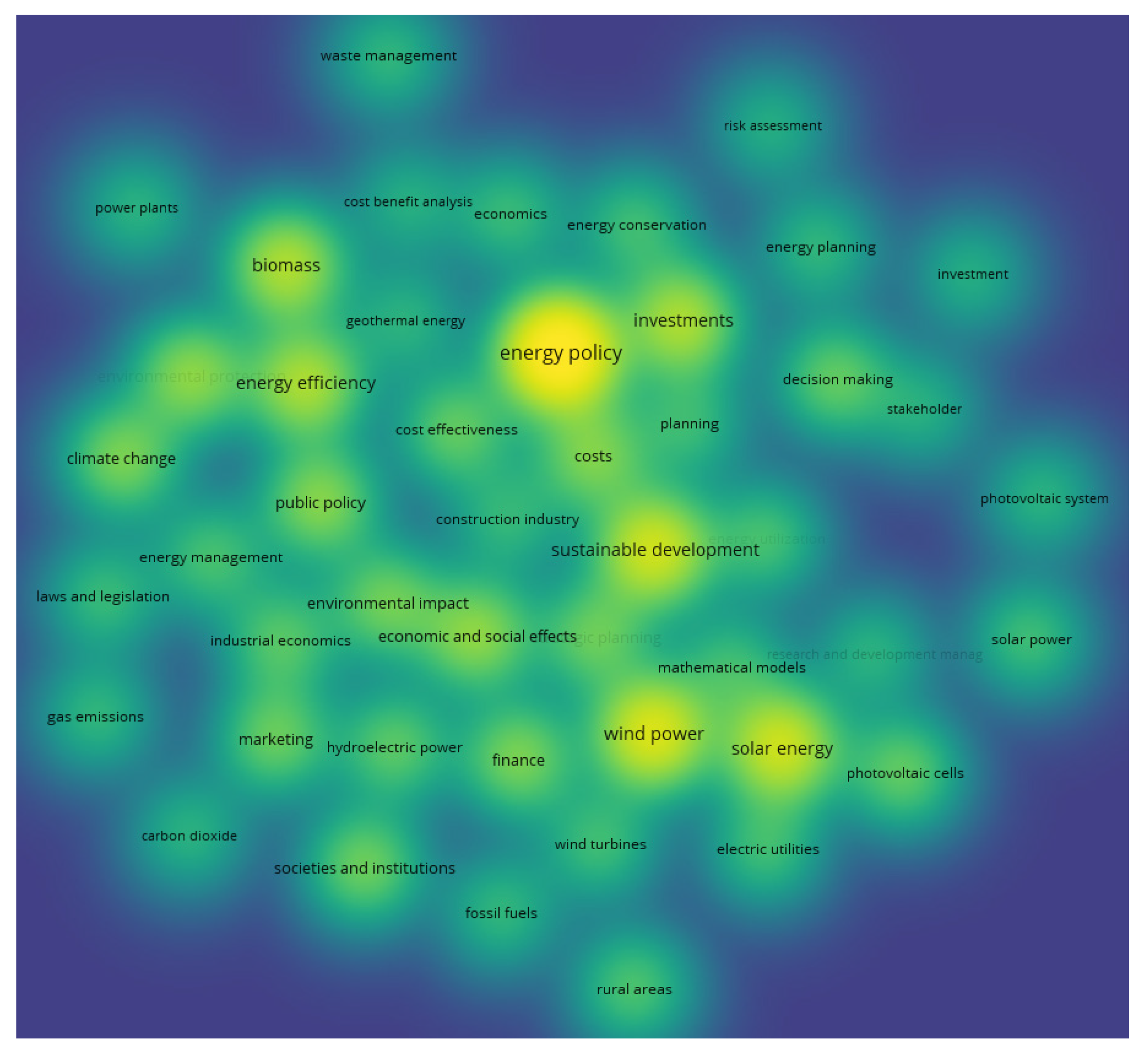
| Journal Title | Number of Articles | % of Articles in the Sample | Number of Citations Received | % of Citations in the Sample |
|---|---|---|---|---|
| Refocus | 39 | 11.64% | 118 | 1.79 |
| Renewable Energy | 38 | 11.34% | 1078 | 16.39 |
| Energy Policy | 26 | 7.76% | 2089 | 31.76 |
| BioCycle | 11 | 3.28% | 7 | 0.11 |
| International Water Power and Dam Construction | 9 | 2.69% | 0.00 | |
| Journal of Cleaner Production | 8 | 2.39% | 184 | 2.80 |
| International Journal of Environmental Studies | 4 | 1.19% | 29 | 0.44 |
| Sustainability (Switzerland) | 4 | 1.19% | 60 | 0.91 |
| Waste Management | 4 | 1.19% | 202 | 3.07 |
| Domain | Areas Needing Further Exploration |
|---|---|
| PM Domain | 1. Development of wind energy projects and green projects |
| 2. Implementation of technology in end-to-end communication architecture for smart grids | |
| 3. Defining success conditions for increased use of Renewable Energy Sources (RES) | |
| 4. Evaluation of Renewable Portfolio Standards (RPS) policy effectiveness | |
| 5. Planning of new material recovery process and management systems | |
| 6. Cost analysis of the current state of technology | |
| 7. Methods for estimating total private and social benefits of landfill gas for energy projects | |
| Technological Domain | 1. Optimal configuration of the system design |
| 2. Optimization of activities related to the recovery of materials and energy | |
| 3. Improving maximization of Net Present Value (NPV) | |
| 4. Comparison of linear regression and k-NN prediction | |
| 5. Review of investments in electricity infrastructure | |
| 6. Development of privately and socially viable projects |
Disclaimer/Publisher’s Note: The statements, opinions and data contained in all publications are solely those of the individual author(s) and contributor(s) and not of MDPI and/or the editor(s). MDPI and/or the editor(s) disclaim responsibility for any injury to people or property resulting from any ideas, methods, instructions or products referred to in the content. |
© 2023 by the authors. Licensee MDPI, Basel, Switzerland. This article is an open access article distributed under the terms and conditions of the Creative Commons Attribution (CC BY) license (https://creativecommons.org/licenses/by/4.0/).
Share and Cite
Piwowar-Sulej, K.; Sołtysik, M.; Jarosz, S.; Pukała, R. The Linkage between Renewable Energy and Project Management: What Do We Already Know, and What Are the Future Directions of Research? Energies 2023, 16, 4609. https://doi.org/10.3390/en16124609
Piwowar-Sulej K, Sołtysik M, Jarosz S, Pukała R. The Linkage between Renewable Energy and Project Management: What Do We Already Know, and What Are the Future Directions of Research? Energies. 2023; 16(12):4609. https://doi.org/10.3390/en16124609
Chicago/Turabian StylePiwowar-Sulej, Katarzyna, Mariusz Sołtysik, Szymon Jarosz, and Ryszard Pukała. 2023. "The Linkage between Renewable Energy and Project Management: What Do We Already Know, and What Are the Future Directions of Research?" Energies 16, no. 12: 4609. https://doi.org/10.3390/en16124609






